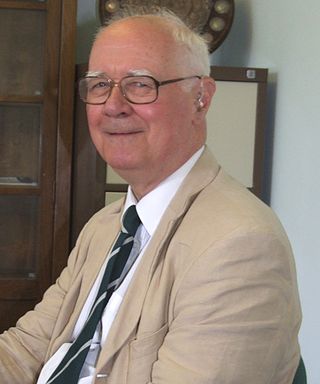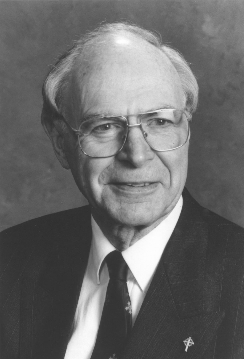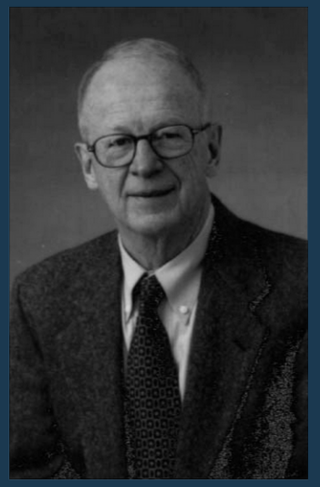
The relationship between religion and science involves discussions that interconnect the study of the natural world, history, philosophy, and theology. Even though the ancient and medieval worlds did not have conceptions resembling the modern understandings of "science" or of "religion", certain elements of modern ideas on the subject recur throughout history. The pair-structured phrases "religion and science" and "science and religion" first emerged in the literature during the 19th century. This coincided with the refining of "science" and of "religion" as distinct concepts in the preceding few centuries—partly due to professionalization of the sciences, the Protestant Reformation, colonization, and globalization. Since then the relationship between science and religion has been characterized in terms of "conflict", "harmony", "complexity", and "mutual independence", among others.

John Charlton Polkinghorne was an English theoretical physicist, theologian, and Anglican priest. A prominent and leading voice explaining the relationship between science and religion, he was professor of mathematical physics at the University of Cambridge from 1968 to 1979, when he resigned his chair to study for the priesthood, becoming an ordained Anglican priest in 1982. He served as the president of Queens' College, Cambridge, from 1988 until 1996.

William Lane Craig is an American analytic philosopher, Christian apologist, author, and Wesleyan theologian who upholds the view of Molinism and neo-Apollinarianism. He is a professor of philosophy at Houston Christian University and at the Talbot School of Theology of Biola University.

The Graduate Theological Union (GTU) is a consortium of eight private independent American theological schools and eleven centers and affiliates. Seven of the theological schools are located in Berkeley, California. The GTU was founded in 1962 and their students can take courses at the University of California, Berkeley. Additionally, some of the GTU consortial schools are part of other California universities such as Santa Clara University and California Lutheran University. Most of the GTU consortial schools are located in the Berkeley area with the majority north of the campus in a neighborhood known as "Holy Hill" due to the cluster of GTU seminaries and centers located there.

Arthur Robert Peacocke was an English Anglican theologian and biochemist.
Ian Graeme Barbour was an American scholar on the relationship between science and religion. According to the Public Broadcasting Service his mid-1960s Issues in Science and Religion "has been credited with literally creating the contemporary field of science and religion."

Wolfhart Pannenberg was a German Lutheran theologian. He made a number of significant contributions to modern theology, including his concept of history as a form of revelation centered on the resurrection of Christ, which has been widely debated in both Protestant and Catholic theology, as well as by non-Christian thinkers.
In philosophy, theophysics is an approach to cosmology that attempts to reconcile physical cosmology and religious cosmology. It is related to physicotheology, the difference between them being that the aim of physicotheology is to derive theology from physics, whereas that of theophysics is to unify physics and theology.

Muzaffar Iqbāl is a Pakistani-Canadian Islamic scholar and author.
Nancey Murphy is an American philosopher and theologian who is Professor of Christian Philosophy at Fuller Theological Seminary, Pasadena, CA. She received the B.A. from Creighton University in 1973, the Ph.D. from University of California, Berkeley in 1980, and the Th.D. from the Graduate Theological Union (theology) in 1987.

William Leonard Rowe was a professor of philosophy at Purdue University who specialized in the philosophy of religion. His work played a leading role in the "remarkable revival of analytic philosophy of religion since the 1970s". He was noted for his formulation of the evidential argument from evil.

Since the emergence of the Big Bang theory as the dominant physical cosmological paradigm, there have been a variety of reactions by religious groups regarding its implications for religious cosmologies. Some accept the scientific evidence at face value, some seek to harmonize the Big Bang with their religious tenets, and some reject or ignore the evidence for the Big Bang theory.

Issues in Science and Religion is a book by Ian Barbour. A biography provided by the John Templeton Foundation and published by PBS online states this book "has been credited with literally creating the contemporary field of science and religion."

William R. Stoeger SJ was an American astronomer and theologian.
Karl Heim was a professor of dogmatics at Münster and Tübingen. He retired in 1939. His idea of God controlling quantum events that do and would seem otherwise random has been seen as the precursor to much of the current studies on divine action. His current influence upon religion and science theology has been compared in degree to that of the physicist and theologian Ian Barbour and of the scientist and theological organizer Ralph Wendell Burhoe. His doctrine on the transcendence of God has been thought to anticipate important points of later religious and science discussions, including the application of Thomas Kuhn's idea of a paradigm to religion and Thomas F. Torrance's theory of multileveled knowledge. Mention of Heim's physical and theological concept of extra-dimensional space can be found in a 2001 puzzle book by the popular mathematics writer Martin Gardner. His concept of space has also been discussed by Ian Barbour himself, who in a review of the book Christian Faith and Natural Science and in a mention of "its more technical sequel" The Transformation of the Scientific World-View, found it to be "an illuminating insight."
Vincent Brümmer was a South African-born Christian theologian who worked for most of his career in the Netherlands. From 1967 to 1997 he was the Professor of Philosophy of Religion at the University of Utrecht.
The Society of Ordained Scientists (SOSc) is an international religious order of priest-scientists within the Anglican Communion. The organisation was founded at the University of Oxford by biologist-theologian Arthur Peacocke following the establishment of several other similar societies in the 1970s, in order to advance the field of religion and science. Membership in the Society of Ordained Scientists is open at the invitation of the Warden to ordained ministers of any Christian denomination upholding belief in the Holy Trinity. As a result, the ecumenical religious order includes individuals from the Anglican Church, Catholic Church, Methodist Church, Eastern Orthodox Church, Reformed Church, and Lutheran Church, among other Christian denominations.

The Blackwell Companion to Science and Christianity is a reference work in science and religion, edited by James B. Stump and Alan G. Padgett, and published by Wiley-Blackwell in 2012. It contains 54 new essays written by an international list of 55 authors, many of them leading scholars in the discipline of science and religion, and others new or up-and-coming voices in the field. The editors claim, "We are seeking to introduce and advance serious thinking and talking about science and Christianity, particularly as they interconnect. We are reflecting on the work of scientists and theologians, trying to find points of contact and points of tension which help to illuminate these practices and doctrines in clear, scholarly light." The book has received positive reviews in Choice, Reference Reviews, Themelios and Perspectives on Science and Christian Faith. The article by Sean M. Carroll generated significant attention when it was discussed on the Huffington Post.
Philip G. Ziegler is a Canadian-born theologian who holds a personal chair as Professor in Christian Dogmatics at the University of Aberdeen. He is author of numerous scholarly articles, books, and has led various research projects within contemporary dogmatics, the theology of Dietrich Bonhoeffer, as well as theological reflection on New Testament apocalyptic. He maintains a personal website: Theologia Borealis.











